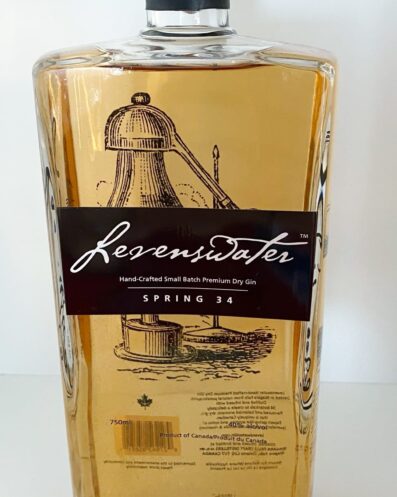The thirty-four in the name refers to the number of botanicals in Levenswater Spring 34. Those botanicals are macerated in potato spirit. While the large number of them are kept as secret, they do share the source of their inspiration: Toronto’s Kensington Market.
The large open air market is a multi-cultural hub in the city. Foods, spices, clothing and more— the gin’s botanical blend pays homage to the diverse range of flavors available.
The color of Levenswater Spring 34 is due to it being a compound gin. There is no secondary distillation of the potato spirit after maceration.
Tasting Notes
Color: Perfectly transparent with an ochre hue.
I did note that other sources have indicated a “pink” hue. Many botanicals and natural colorings are photo-reactive and change hue based on time and exposure to sunlight or heat. Despite not being pink, the color is still rather attractive, though it appears more similar to an aged gin.
Aroma: Lavender floral with some hints of brown sugar and spice. There’s a rich melange of notes including sweet birch beer, ginger, garam masala, curry powder, and rose petals.
Flavor: Complex and bold, there’s an immense amount of flavor in here. Sweet spices predominate, with ginger, lavender and cardamom early. Mid-palate cinnamon, birch bark, nutmeg, and a hint of citrus suggestive of cola.
Finish: Some nice flavors segue into a rather bitter finish. Natural tannins and astingency come together. As you sip more, they build on the palate. This is one of the characteristics of the style however.
Cocktails
Compound gins are notoriously hard to mix with. If you’ve ever tried one of those “make your own gin at home” kits, you know the difficulties first hand. Color can be an issue in some cocktails. Second, the flavor profile of macerated botanicals is very different than that of their distilled counterparts (there’s a lot to do with solubility and volatility, if you want to nerd out about it).
I recommend treating compound gins like Levenswater Spring 34 as their own thing— and not expecting them to work 1:1 with distilled gins.
Levenswater Spring 34 works great in a Hot Toddy. Even pairing it with tea brings forth those natural ingredients; the hot water helps some of those beautiful aromas to volatilize. I recommend pairing it with some honey, because the sweetness takes the edge off the finish.
Sweetness is essential in mixing with this gin to help counteract the bitterness. I think it works well in a Gin and Tonic, especially garnished with some fresh citrus. The bitterness on the finish works against Levenswater Spring 34 in a Martini because it amplifies the wormwood creating a somewhat “too bitter” impression. Try it instead in a Negroni. Swap the Campari out for Cynar and you’ll get an intense, botanical drink that really highlights the gin’s natural spice.
Overall, Levenswater Spring 34
I appreciate the concept and the attempt to make a bold compound-style gin. However, the bitterness on the end is rather stark— especially when compared to others in this category.
Secondly, the flavor profile is all over. It lacks focus and centering.
And thirdly, and most importantly— juniper is in here, but you won’t pick up on any of it in here. While technically a gin, it lacks any perceptible juniper. It may be more technically successful as a compound botanical spirit. Or with some added sweetening, it might be a good amaro.
Gin drinkers will be disappointed to find scant juniper among the botanical riches present here.

